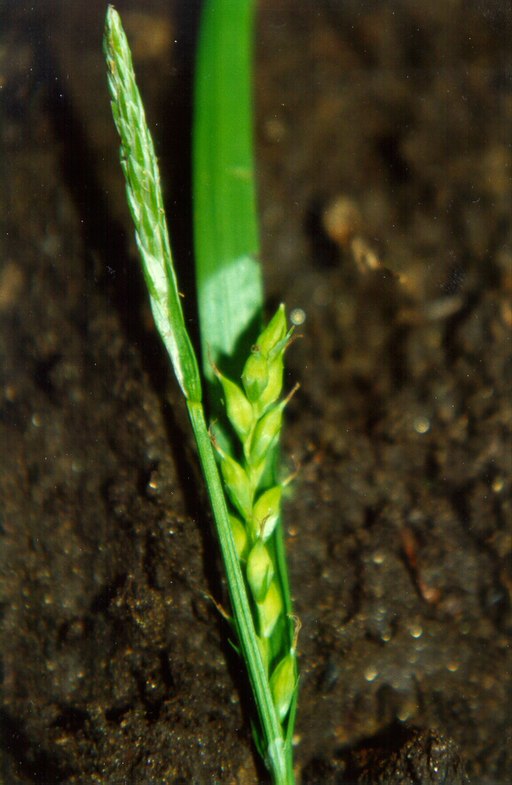Classification System: APG IV
Superregnum: Eukaryota
Regnum: Plantae
Cladus: Angiosperms
Cladus: Monocots
Cladus: Commelinids
Ordo: Poales
Familia: Cyperaceae
Subfamilia: Cyperoideae
Tribus: Cariceae
Genus: Carex
Species: Carex hendersonii
Name
Carex hendersonii L.H.Bailey, Proc. Amer. Acad. Arts 22: 115 (1887).
Synonyms
Heterotypic
Carex laxiflora var. plantaginea Olney, Proc. Amer. Acad. Arts 8: 407 (1872).
Distribution
Native distribution areas:
Continental: Northern America
British Columbia, California, Idaho, Oregon, Washington
References: Brummitt, R.K. 2001. TDWG – World Geographical Scheme for Recording Plant Distributions, 2nd Edition
References
Primary references
Bailey, L.H., 1886- Proceedings of the American Academy of Arts and Sciences. Boston, MA 22: 115 (1886) "hendersoni"
Links
Govaerts, R. et al. 2020. Carex hendersonii in Kew Science Plants of the World Online. The Board of Trustees of the Royal Botanic Gardens, Kew. Published online. Accessed: 2020 Jan 20. Reference page.
International Plant Names Index. 2020. Carex hendersonii. Published online. Accessed: Jan 20 2020.
Govaerts, R. et al. 2020. Carex hendersonii in Kew Science Plants of the World Online. The Board of Trustees of the Royal Botanic Gardens, Kew. Published online. Accessed: 2020 Jan 20. Reference page.
Tropicos.org 2020. Carex hendersonii. Missouri Botanical Garden. Published online. Accessed: 20 Jan 2020.
USDA, ARS, Germplasm Resources Information Network. Carex hendersonii in the Germplasm Resources Information Network (GRIN), U.S. Department of Agriculture Agricultural Research Service. Accessed: 13 Aug 2006.
Vernacular names
English: Henderson's sedge
Carex hendersonii, also known as Henderson's sedge or carex de Henderson,[1] is a tussock-forming species of perennial sedge in the family Cyperaceae. It is native to western parts of North America.[2]
Contents
1 Description
2 Taxonomy
3 Distribution
4 See also
5 References
Description
The sedge has densely tufted brownish coloured culms that are 45 to 87 cm (18 to 34 in) in length and 2 to 2.2 mm (0.079 to 0.087 in) wide. The green leaves have basal green sheaths that become lighter near the base. The corrugate leaf blades are ascending and are 19 to 52 cm (7.5 to 20.5 in) in length and 3 to 16 mm (0.12 to 0.63 in) wide. The inflorescences occur at the end of lateral stalks as spikes that are 1 to 15 cm (0.39 to 5.91 in) in length.[3] In California it blooms between May and June.[4]
Taxonomy
The species was first described by the botanist Liberty Hyde Bailey in 1887 as a part of the Proceedings of the American Academy of Arts and Sciences.[5] It has one synonym; Carex laxiflora var. plantaginea as described by Olney in 1872.[2]
Distribution
The plant is found in temperate biomes from south western Canada in British Columbia[1] and the range extends down the western parts of the United States through [[Washington (state}|Washington]], Oregon to as far south as California[2] It is just as likely to be found in wetland as non-wetland environments including coastal prairie and oak woodlands.[4]
See also
List of Carex species
References
"Carex hendersonii L.H. Bailey". VASCAN. Canadensys. Retrieved 7 November 2022.
"Carex hendersonii L.H.Bailey". Kew Science – Plants of the World Online. Retrieved 6 November 2022.
"Carex hendersonii L.H.Bailey". World Flora Online. Retrieved 7 November 2022.
"Carex hendersonii L. H. Bailey". Calflora. Retrieved 7 November 2022.
"Carex hendersonii L.H. Bailey". Tropicos. Missouri Botanical Garden. Retrieved 7 November 2022.
Retrieved from "http://en.wikipedia.org/"
All text is available under the terms of the GNU Free Documentation License


